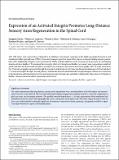Files in this item
Expression of an activated integrin promotes long-distance sensory axon regeneration in the spinal cord
Item metadata
| dc.contributor.author | Cheah, Menghon | |
| dc.contributor.author | Andrews, Melissa Renee | |
| dc.contributor.author | Chew, Daniel | |
| dc.contributor.author | Moloney, Elizabeth | |
| dc.contributor.author | Verhaagen, Joost | |
| dc.contributor.author | Fassler, Reinhard | |
| dc.contributor.author | Fawcett, James | |
| dc.date.accessioned | 2016-07-12T11:30:12Z | |
| dc.date.available | 2016-07-12T11:30:12Z | |
| dc.date.issued | 2016-07-06 | |
| dc.identifier | 243606485 | |
| dc.identifier | 6f7403bd-f15a-4174-b201-4b8b27530057 | |
| dc.identifier | 84977543684 | |
| dc.identifier | 000379021800018 | |
| dc.identifier.citation | Cheah , M , Andrews , M R , Chew , D , Moloney , E , Verhaagen , J , Fassler , R & Fawcett , J 2016 , ' Expression of an activated integrin promotes long-distance sensory axon regeneration in the spinal cord ' , The Journal of Neuroscience , vol. 36 , no. 27 , pp. 7283-7297 . https://doi.org/10.1523/JNEUROSCI.0901-16.2016 | en |
| dc.identifier.issn | 0270-6474 | |
| dc.identifier.uri | https://hdl.handle.net/10023/9117 | |
| dc.description | This work was supported by grants from the Christopher and Dana Reeve Foundation, the Medical Research Council, the European Research Council ECMneuro, and the Cambridge National Health and Medical Research Council Biomedical Research Centre. | en |
| dc.description.abstract | After CNS injury, axon regeneration is blocked by an inhibitory environment consisting of the highly upregulated tenascin-C and chondroitin sulfate proteoglycans (CSPGs). Tenascin-C promotes growth of axons if they express a tenascin-binding integrin, particularly α9β1. Additionally, integrins can be inactivated by CSPGs, and this inhibition can be overcome by the presence of a β1-binding integrin activator, kindlin-1. We examined the synergistic effect of α9 integrin and kindlin-1 on sensory axon regeneration in adult rat spinal cord after dorsal root crush and adeno-associated virus transgene expression in dorsal root ganglia. After 12 weeks, axons from C6–C7 dorsal root ganglia regenerated through the tenascin-C-rich dorsal root entry zone into the dorsal column up to C1 level and above (25mm axon length) through a normal pathway. Animals also showed anatomical and electrophysiological evidence of reconnection to the dorsal horn and behavioral recovery in mechanical pressure, thermal pain, and ladder-walking tasks. Expression of α9 integrin or kindlin-1 alone promoted much less regeneration and recovery. | |
| dc.format.extent | 15 | |
| dc.format.extent | 7548168 | |
| dc.language.iso | eng | |
| dc.relation.ispartof | The Journal of Neuroscience | en |
| dc.subject | Adeno-associated virus | en |
| dc.subject | Alpha9 integrin | en |
| dc.subject | Axon regeneration | en |
| dc.subject | Dorsal root ganglion | en |
| dc.subject | Kindlin-1 | en |
| dc.subject | Spinal cord | en |
| dc.subject | RC0321 Neuroscience. Biological psychiatry. Neuropsychiatry | en |
| dc.subject | Neuroscience(all) | en |
| dc.subject | NDAS | en |
| dc.subject.lcc | RC0321 | en |
| dc.title | Expression of an activated integrin promotes long-distance sensory axon regeneration in the spinal cord | en |
| dc.type | Journal article | en |
| dc.contributor.institution | University of St Andrews. School of Medicine | en |
| dc.identifier.doi | https://doi.org/10.1523/JNEUROSCI.0901-16.2016 | |
| dc.description.status | Peer reviewed | en |
This item appears in the following Collection(s)
Items in the St Andrews Research Repository are protected by copyright, with all rights reserved, unless otherwise indicated.

